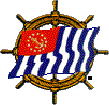 |
|
|
|---|---|---|
Flag and Etiquette
|
Do It Right! |
|
|
|
||
Approval Process for New and Revised District Flags
Many districts of USPS have adopted a distinctive flag to identify themselves and their squadrons' members. A district flag is an association flag, not a club burgee, and is not to be worn on a vessel without a squadron burgee. The flag must be rectangular and must display the district number prominently as either a number (e.g., "4", "D/4" or "IV") or as a graphic depiction (e.g., 4 stars.) Designs should be simple and bold so as to be distinguishable at a distance. It is preferable that the flag have a pattern that reads correctly from both sides. For maximum recognition, other wording should be held to a minimum.
District Flags must be approved by the the national secretary (who has been delegated that responsibility by the Governing Board) upon recommendation by the Flag and Etiquette Committee (FECom). FECom, in turn, requires the approval of the district. Districts proposing a new flag or districts desiring to modify their design should make introductory inquiry of the assistant chairman of FECom to ascertain whether their proposed flag meets fundamental technical requirements and general USPS guidelines. When the above steps have been completed, a formal petition may then be made to the assistant chairman of the FECom and must include:
- Certificate from the district commander (or secretary) acknowledging district approval, with the date.
- A brief discussion of the heraldry or significance of the design.
- Either a digital image of the design, with accurate portrayal of its colors, measuring approximately 7 x 10 inches on the fly, or a picture of similar size that can be scanned into such an image. Transmittal of either of these may be by any appropriate method. Should this be difficult or impossible, the district should consult the assistant chairman of FECom, who will work to achieve a satisfactory result. A FECom member will edit the depiction as required to render a suitable copy for projection at a Governing Board meeting and inclusion on the FECom web page.
FECom will take the proposed design under advisement and will endeavor to work with the proposing district if it deems the design defective. Ultimately, it will report its assessment and recommendation to the National Secretary.
A 12 x 18 production sample of the flag must be provided to FECom within six months of the flag's approval.
In addition to design criteria noted above, a district flag should not contain a spelled name. Its motif should be based on the district's number, some local geographic or historic feature or in some other way reflect the district's area of operation.
Color combinations should be selected from the standard basic colors red, orange, yellow, green, blue, white and black. Intricate designs and a multitude of colors should be avoided from the standpoint of costs of manufacturing and reproduction on printed matter. A proposed flag must not conflict with any other burgee or flag of a U.S. or Canadian squadron or district [View Current Squadron Burgees and District Flags], or with a burgee or private signal already recorded in a recognized reference work such as the International Burgee Registry or the former Lloyd's Register of American Yachts. Further, it should be remembered that arranging for manufacturing and supply of flags is solely the responsibility of the individual district.
The North American Vexillological Association (NAVA) provides 5 principles that should be followed when designing any new flag in Good Flag—Bad Flag, How to Design A Great Flag. It uses actual flags to demonstrate what a good flag looks like and what a bad flag looks like. Districts should review this information closely because FECom uses these guidelines when evaluating new flags.
When a district dissolves, merges or consolidates, its flag is deemed to be retired unless through merger or consolidation the design is adopted by the surviving unit. FECom is to be consulted in the latter event.

|
|
